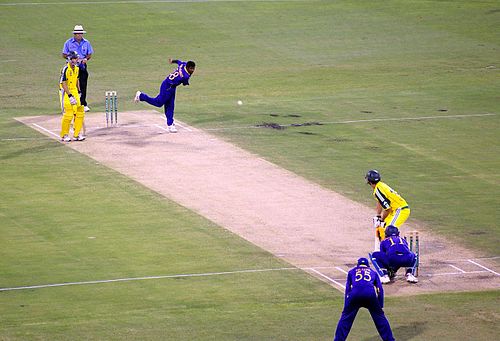The two batsmen take positions at opposite ends of the pitch. One designated member of the fielding team, called the bowler, bowls the ball from one end of the pitch to the striking batsman at the other end. The batsman at the bowling end is called the non-striker, and stands to the side of his wicket, behind his crease. The batsman are allowed to step forward of their creases, though at some risk. Another member of the fielding team, the wicket keeper, is positioned behind the striker's wicket.
The fielding team's other nine members stand outside the pitch, spread out across the field. The fielding captain often strategically changes their position between balls.
There is always an umpire at each end of the pitch.
The bowler usually retreats a few yards (metres) behind the wicket, runs towards it (his run-up), and then releases the ball over-hand as he reaches the bowling crease. (If he crosses the crease before he releases the ball, or if he flexes his elbow too much in a throw, then it is a no ball, and the batting team gets a penalty orextra run. If the ball passes the far wicket out of reach of the batsman then it is called a wide, also with an extra run.) The ball can be bowled so that it bounces on the pitch, lands exactly on the crease (a yorker), or crosses the crease without bouncing (a full toss).
The batsman tries to prevent the ball from hitting the wicket by striking the ball with his bat. (This includes the handle of the bat, and his gloves.) If the bowler succeeds in putting down the wicket the batsman is dismissed and is said to be bowled out. If the batsman misses the ball, but any part of his body prevents it from reaching the wicket, then he is out leg before wicket, or "LBW".
If the batsman hits the ball but it is caught by a fielder without bouncing then he is caught out. If it is caught by the bowler then he is caught and bowled; by the wicket keeper, caught behind.
If the batsman is successful in striking the ball and it is not caught without bouncing, then the two batsmen may try to score points (runs) for their team. Both batsmen run the length of the pitch, exchanging positions, and grounding their bats behind the opposite crease. Each crossing and grounding by both batsmen is worth one run. The batsmen may attempt one run, multiple runs, or elect not to run at all. By attempting runs, the batsmen risk dismissal. This happens if the fielding team retrieves the ball and hits either wicket with the ball (either by throwing it, or while holding it) before the batsman who owns that wicket reaches hisground behind the crease. The dismissed batsman is run out. Batsmen will sometimes start to run, change their mind, and return to their original positions.
If the batsman hits the ball over the field boundary without the ball touching the field, the batting team scores six runs. If the ball touches the ground and then reaches the boundary, the batting team scores four runs. The batsmen might start running before the ball reaches the boundary, but those runs don't count.
If the batsman misses the ball they can still attempt extra runs : these are called byes. If the ball bounces off his body then it is called a leg bye.
If the striking batsman leaves his ground and misses the ball, then the wicket keeper can catch it and put down the wicket – stumped.
In case of a no ball or a wide the batsman can choose to strike the ball, earning runs in addition to the fixed penalty. If he does so he can only be dismissed by being run out.

No comments:
Post a Comment